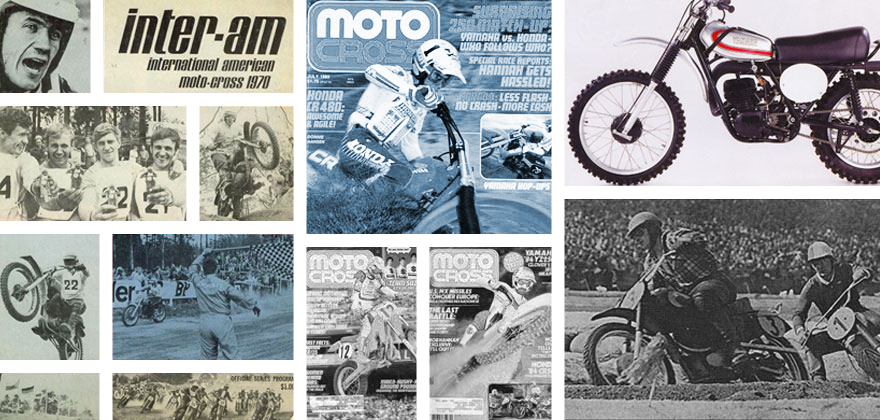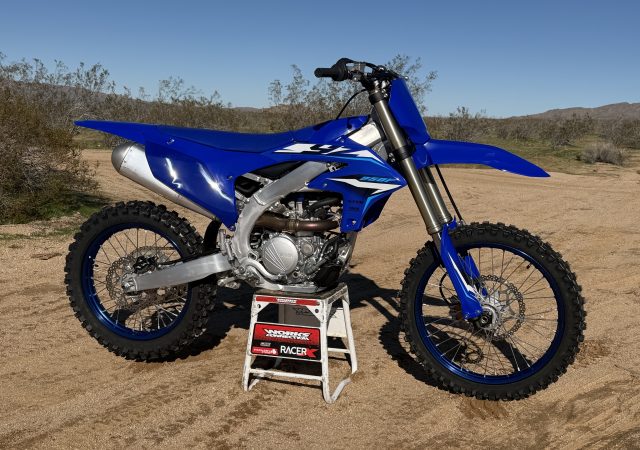
For this edition of Classic Steel, we are going to take a look back at Yamaha’s 1994 YZ250.
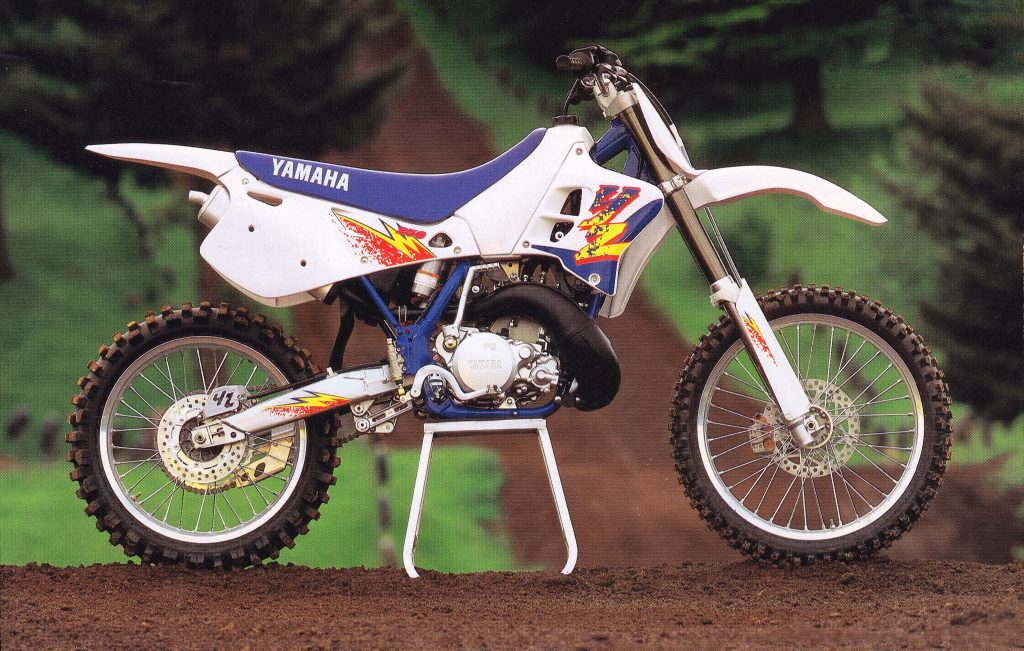 All-new in 1993, Yamaha’s YZ250 was updated and refined for 1994. Photo Credit: Yamaha
All-new in 1993, Yamaha’s YZ250 was updated and refined for 1994. Photo Credit: Yamaha
All-new in 1993, Yamaha’s YZ250 was the sleeper of the early nineties 250 class. While machines like Honda’s CR250R stole the headlines with rocket-fast motors and razor-sharp turning, Yamaha’s Steady Eddie deuce-and-a-half got the job done with great do-it-all handling, well-sorted suspension, and easy-to-ride motors. The YZ was rarely the best at any one thing, but the sum of its parts always added up to one of the best all-around racers in the class.
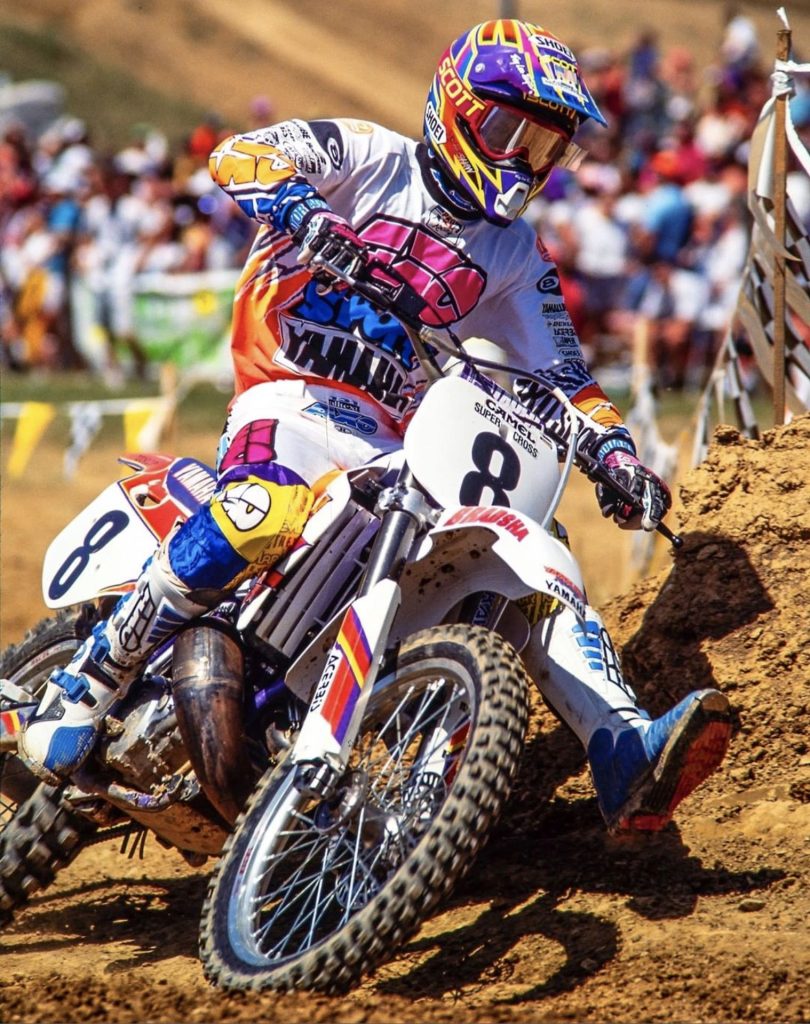 By far the biggest story of the 1994 season was the sudden retirement of Yamaha’s Damon Bradshaw. After a season that saw the mercurial star capture three victories, he shocked the industry by walking away from a multi-million-dollar contract at the end of the 1993 season. Photo Credit: Chris Hultner
By far the biggest story of the 1994 season was the sudden retirement of Yamaha’s Damon Bradshaw. After a season that saw the mercurial star capture three victories, he shocked the industry by walking away from a multi-million-dollar contract at the end of the 1993 season. Photo Credit: Chris Hultner
In 1993, that scenario once again played out with a machine that was deceptively fast, well-suspended, and very competitive. The YZ’s new bodywork was handsome, comfortable, and slimmer than in the past, and its revamped chassis was stout and rock solid at speed. Its smooth motor was less exciting than the Honda’s, and its suspension was not as cushy as the Kawasaki, but if you were looking for a buy-it-and-race-it machine the YZ was hard to beat.
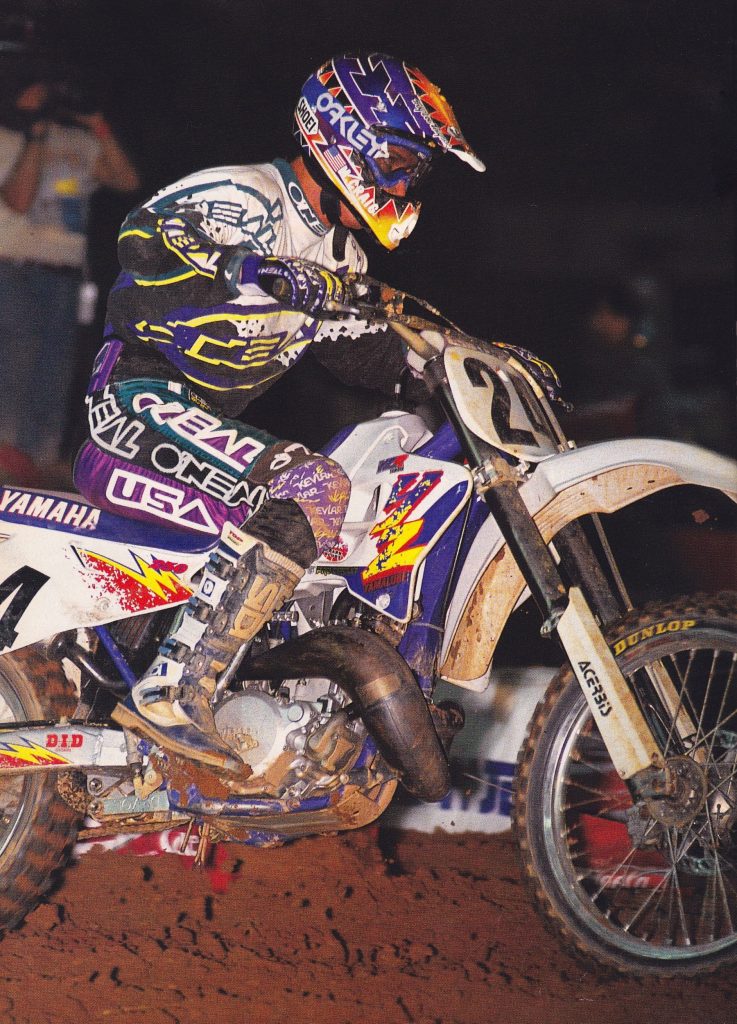 With Bradshaw’s shocking retirement, Yamaha was left looking for someone to fill his very large boots for 1994. In the end, they turned to El Cajon California’s Micheal Ray Craig. Prior to 1994, the man they called the “Stingray” had shown tons of potential, winning rounds and finishing in the top five repeatedly in the 125 class. The move to the Factory Yamaha team was a major upgrade in support for Craig, but the new position came with tremendously high expectations. Photo Credit: Chris Hultner
With Bradshaw’s shocking retirement, Yamaha was left looking for someone to fill his very large boots for 1994. In the end, they turned to El Cajon California’s Micheal Ray Craig. Prior to 1994, the man they called the “Stingray” had shown tons of potential, winning rounds and finishing in the top five repeatedly in the 125 class. The move to the Factory Yamaha team was a major upgrade in support for Craig, but the new position came with tremendously high expectations. Photo Credit: Chris Hultner
While the 1993 YZ250 was a very competitive machine, it was certainly not without fault. Most riders liked the YZ’s motor, but very few loved it. Its wide powerband and smooth delivery made it easy to ride and race, but its lack of hit made it feel slower than it was. On the track, it had little trouble hanging with its rivals, but even less experienced riders asked for a bit more “braapp” in its delivery. With its wide powerband, the YZ demanded fewer shifts than many of its rivals, but its transmission and clutch were a step behind the best in the class. Full power shifts were nearly impossible without backing off the throttle and feeding in some clutch and its engagement remained notchy even under a light load. The clutch dragged when cold and faded when hot and most riders found it was better to avoid abusing it if you wanted it to survive the whole moto.
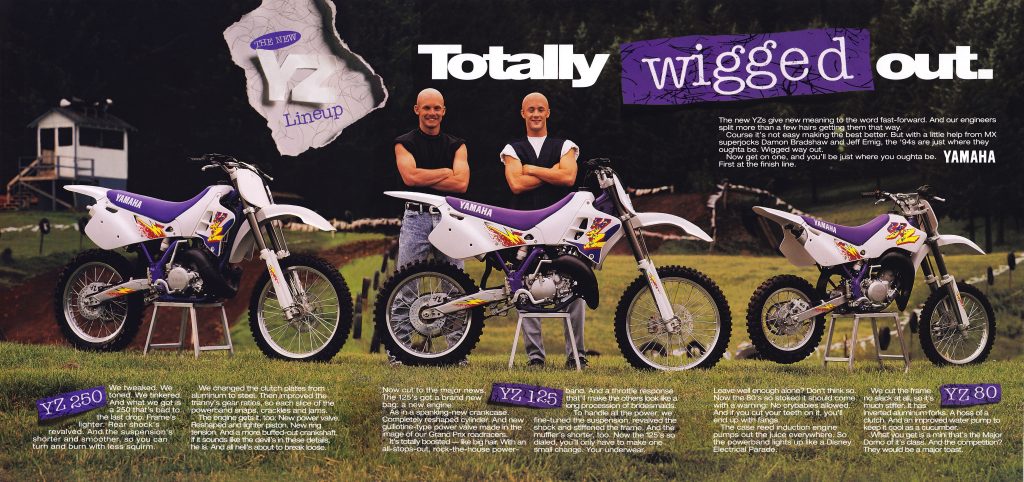 Yamaha’s print ads in the early nineties were epic, but the appearance of Bradshaw front and center had to be bittersweet for the Yamaha brass and his many fans. Ironically, something very similar would happen five years later when a newly-defected-to-Honda Kevin Windham would appear in all the ads for the 1999 YZs. Photo Credit: Yamaha
Yamaha’s print ads in the early nineties were epic, but the appearance of Bradshaw front and center had to be bittersweet for the Yamaha brass and his many fans. Ironically, something very similar would happen five years later when a newly-defected-to-Honda Kevin Windham would appear in all the ads for the 1999 YZs. Photo Credit: Yamaha
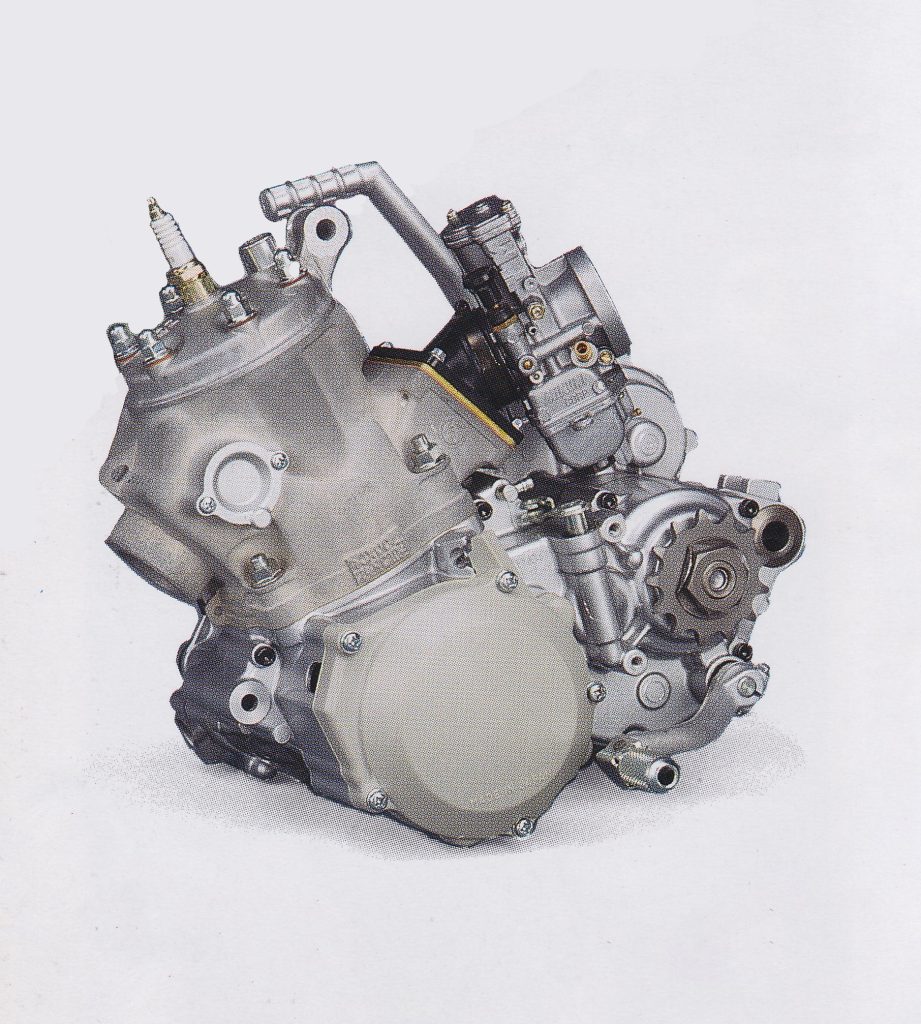 The 249cc mill employed by the YZ250 in 1994 was easily the oldest design found in the 250 class. With roots that reached back to 1982, it remained competitive despite its advancing age. Photo Credit: Yamaha
The 249cc mill employed by the YZ250 in 1994 was easily the oldest design found in the 250 class. With roots that reached back to 1982, it remained competitive despite its advancing age. Photo Credit: Yamaha
For 1994, Yamaha looked to spice up the Why-Zed’s personality, refine its handling, and exorcise a bit of the crankiness from its drivetrain. First up was an all-new top end that added a revised shape for the exhaust and transfer ports and a reshaped drum for the Yamaha Power Valve System (YPVS). The YVPS governor was also modified to open earlier, and the crank’s inertia was boosted by 7%. The ignition was changed to produce a longer spark and the exhaust was reshaped to improve mid and top-end power. All-new ratios for the transmission moved second, third, and fourth closer together while stretching out fifth for a bit more top-end speed. In the clutch, steel plates replaced the alloy plates of 1993 to provide greater durability and more consistent action. A new outer cover was also added with 10% more preload for the springs to further refine its engagement.
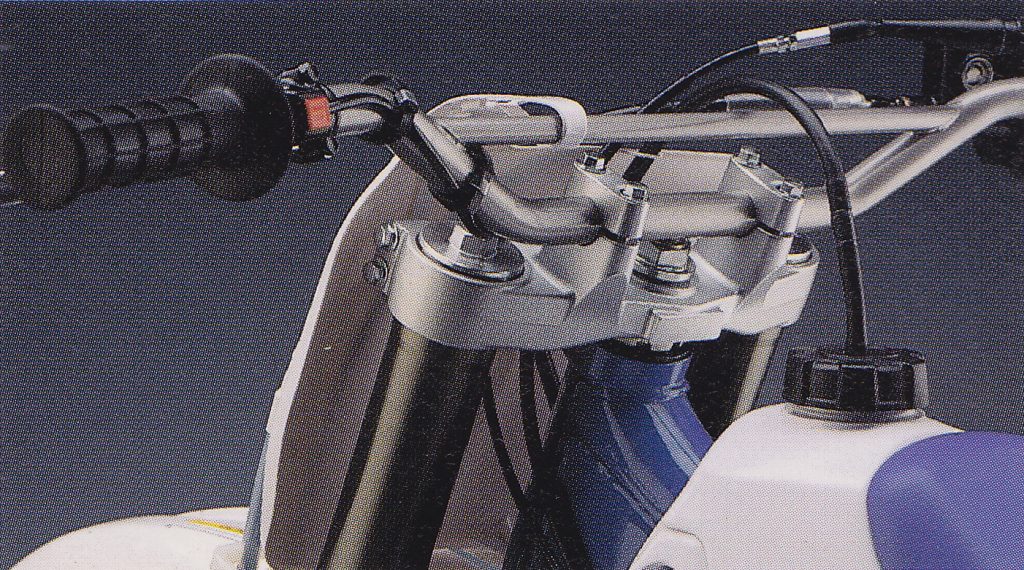 All-new clamps for 1994 adjusted the fork offset slightly and moved to solid mounts for the bars. Photo Credit: Yamaha
All-new clamps for 1994 adjusted the fork offset slightly and moved to solid mounts for the bars. Photo Credit: Yamaha
On the chassis front, the YZ’s updates were less dramatic. In 1993, most riders liked the Yamaha’s combination of solid turning and confidence-inspiring stability. It was not as nimble as the hyper Honda and Suzuki, and not as imperturbable at speed as the Kawasaki, but was far better at turning than the KX and not nearly as scary as the shaky twins once the track got fast. It was a great middle-of-the-road chassis that did a bit of everything and rarely left you hanging out to dry.
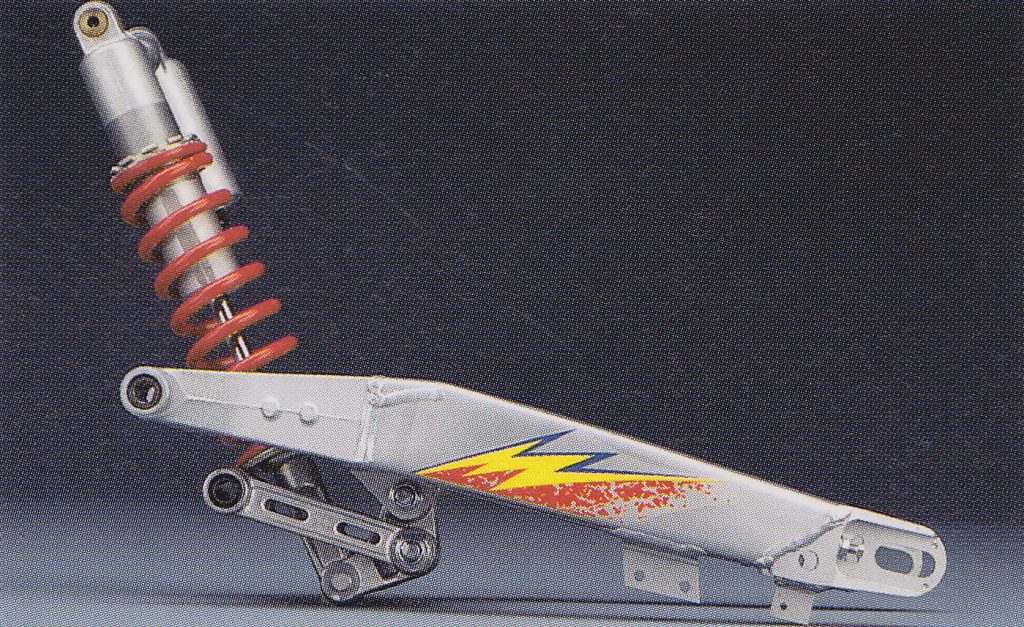 An all-new suspension for 1994 reduced travel by 10mm and added a lighter and stronger rear swingarm. Photo Credit Yamaha
An all-new suspension for 1994 reduced travel by 10mm and added a lighter and stronger rear swingarm. Photo Credit Yamaha
For 1994, Yamaha kept the chassis changes pretty conservative with the most dramatic updates being a new coat of purple paint for the frame, some additional gusseting for the steering head, and a slight repositioning of the footpegs. The pegs were moved up 5mm and a new taller and flatter seat was added to further refine the YZ’s rider compartment. New clamps added 3mm of additional steering lock and altered the fork offset slightly. The new clamps were stronger as well and moved to a solid mounting for the bars. A redesigned handlebar offered a flatter bend for 1994 designed to work better with the new taller pegs and seat. New rotors beefed up the mounting points to reduce flex and moved to holes for venting instead of the slots used in 1993. Pad material was also updated, and new levers front and rear offered a revised shape for improved feel and a more tucked-in profile to reduce the chance of catching on the rider’s boot by accident.
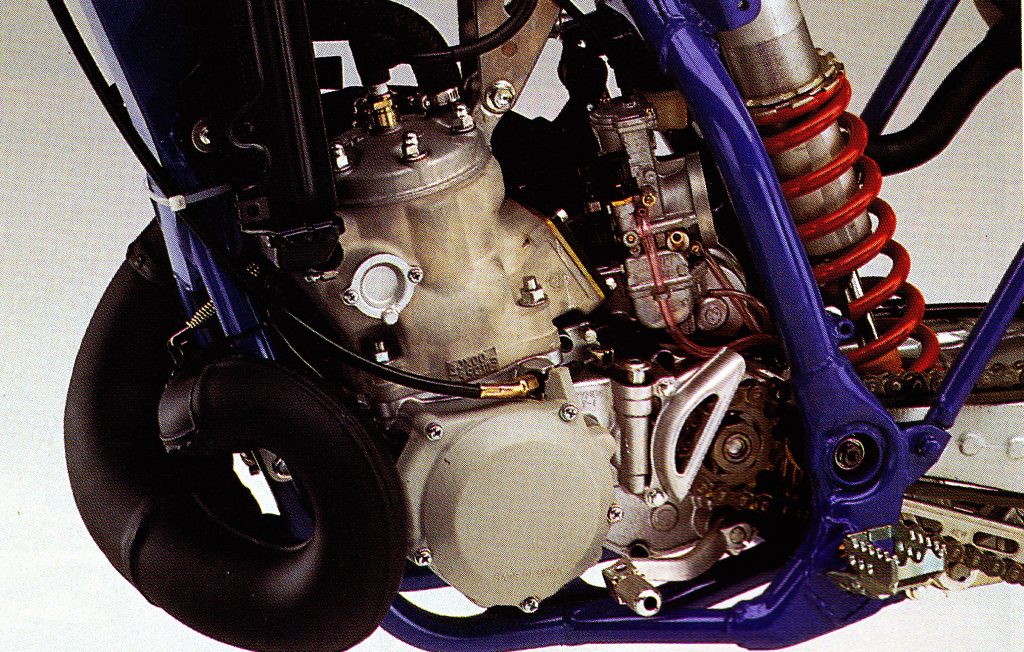 Motor changes for 1994 included revised porting, an updated ignition, a retimed and reshaped YPVS valve, a heavier crank, beefed-up clutch, and all-new ratios for the YZ’s five-speed transmission. Photo Credit: Yamaha
Motor changes for 1994 included revised porting, an updated ignition, a retimed and reshaped YPVS valve, a heavier crank, beefed-up clutch, and all-new ratios for the YZ’s five-speed transmission. Photo Credit: Yamaha
While the frame was largely unchanged, Yamaha did make the interesting choice to shorten the YZ’s suspension for 1994. Yamaha felt lowering the bike would improve its turning and both the forks and shock were shortened by 10mm. Up front, the shortened Kayaba inverted forks featured revised valving and slightly stiffer springs for 1994. The new forks offered 11.8 inches of travel with a full range of external adjustments for compression and rebound damping.
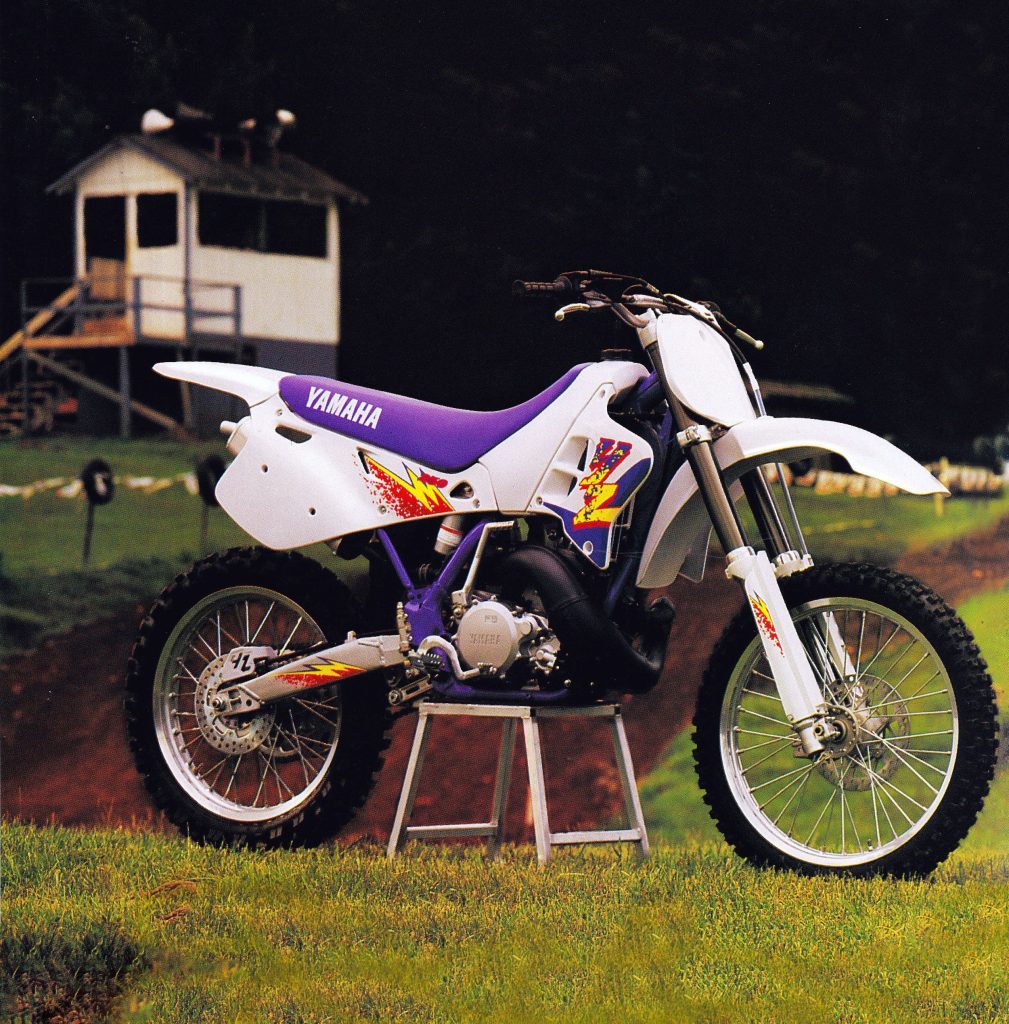 The lavender and lighting bolts motif Yamaha chose for the 1994 YZs was not universally praised at the time. Many more conservative riders thought it was a bit cartoony and ridiculous, but it was the early nineties, so when in Rome… Photo Credit: Yamaha
The lavender and lighting bolts motif Yamaha chose for the 1994 YZs was not universally praised at the time. Many more conservative riders thought it was a bit cartoony and ridiculous, but it was the early nineties, so when in Rome… Photo Credit: Yamaha
In the rear, a new shock offered 4mm less stroke and a 4mm larger piston for improved damping performance. The revamped damper featured a stiffer spring and all-new valving for 1994. The linkage was unchanged but a new swingarm was stronger and lighter than the year before. The upper chain roller was reduced in size to feed torque to the chain later in the travel. The updated shock offered 12.4 inches of travel with external adjustments available for spring preload, compression, and rebound damping.
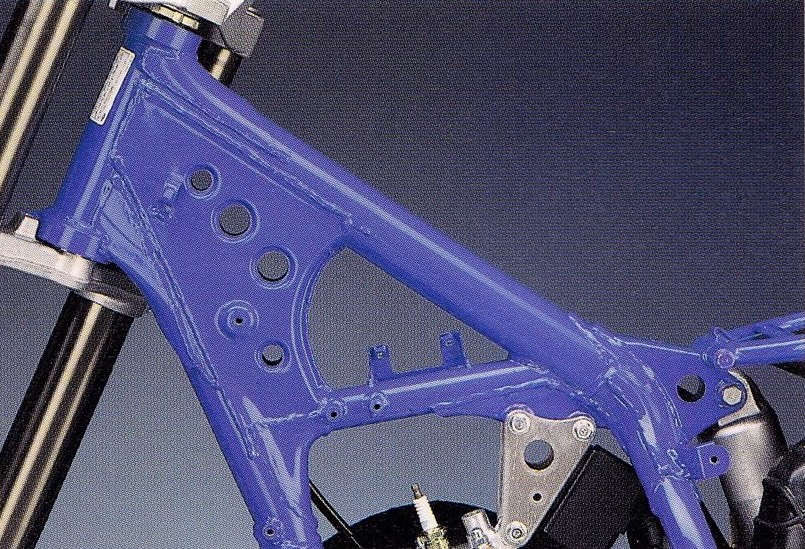 Frame updates for 1994 were limited to reinforcements for the steering head and repositioning of the footpegs to sit 5mm higher on the chassis. Photo Credit: Yamaha
Frame updates for 1994 were limited to reinforcements for the steering head and repositioning of the footpegs to sit 5mm higher on the chassis. Photo Credit: Yamaha
Cosmetically, the YZ was very similar to the year before with the new purple frame offering the most dramatic update to its appearance. Bodywork was unchanged except for the taller seat and updated mounting points for the shrouds and side plates. In 1993, the mounting bolts had tended to pull through the flange and allow the bodywork to come loose so Yamaha beefed up the mounting points to prevent this inconvenience for 1994. Updated graphics added lightning bolts for additional speed and even more purple to make the new YZ250 1990s moto appropriate. At $4899 the YZ increased in cost by $450 from 1993, but this was in line with all its rivals except the Kawasaki which undercut the other Big Four by $150 in 1994.
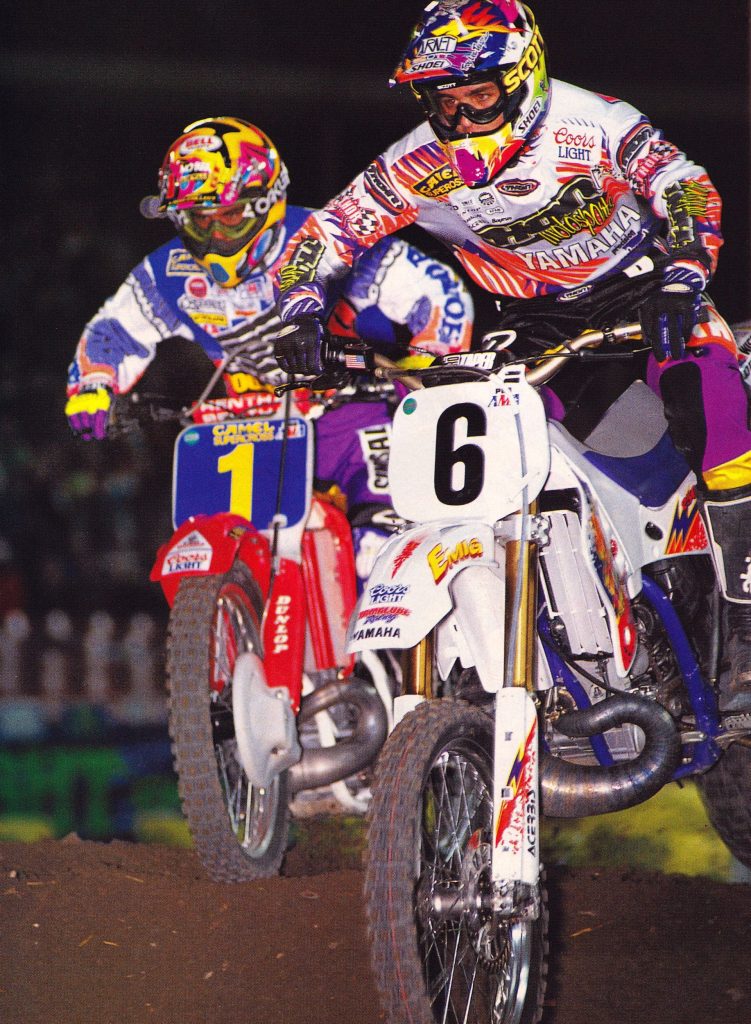 The retirement of Damon Bradshaw thrust 1992 125 National Motocross champion Jeff Emig into the lead role of Yamaha’s 1994 efforts. The Missouri native regularly put his YZ250 at the front of the pack, but he was unable to hold off the likes of Jeremy McGrath for 20 laps under the lights. Photo Credit: Dirt Bike
The retirement of Damon Bradshaw thrust 1992 125 National Motocross champion Jeff Emig into the lead role of Yamaha’s 1994 efforts. The Missouri native regularly put his YZ250 at the front of the pack, but he was unable to hold off the likes of Jeremy McGrath for 20 laps under the lights. Photo Credit: Dirt Bike
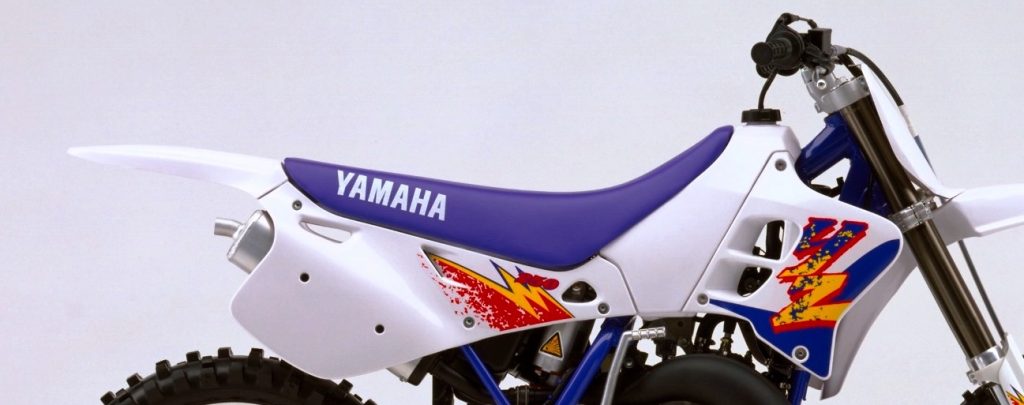 A revamped seat for 1994 was taller through the middle to flatten the rider compartment and facilitate easier rider movement. Photo Credit: Yamaha
A revamped seat for 1994 was taller through the middle to flatten the rider compartment and facilitate easier rider movement. Photo Credit: Yamaha
On the track, the 1994 YZ250 turned out to be exactly what most riders expected – an improved version of the 1993 machine. The motor updates beefed up the power slightly, but the powerband remained very similar to 1993. That meant lots of low-end torque, a smooth midrange, and decent overrev on top. The motor picked up better off the bottom and could hook up on virtually any surface. There remained very little explosive hit, and this once again made the bike feel slower than it really was. On the dyno, it pumped out 44.7 horsepower, nearly 2 horsepower more than the Honda and the most of any 250 in 1994. Honda’s CR250R exploded with far more intensity in the midrange, and this made it seem considerably faster than the YZ, but one look at the two coming off the line or out of a turn told a different story. While the Honda and Suzuki were barking and lighting up the rear tire, the sneaky fast YZ was hooking up and sending every one of its nearly 45 ponies to the terra firma. On slick surfaces, the YZ was like a cheat code with its rear tire glued to the track and rocketing the Yamaha to the front. In deep loam, the YZ’s advantage disappeared somewhat but it remained deceptively fast and super easy to ride.
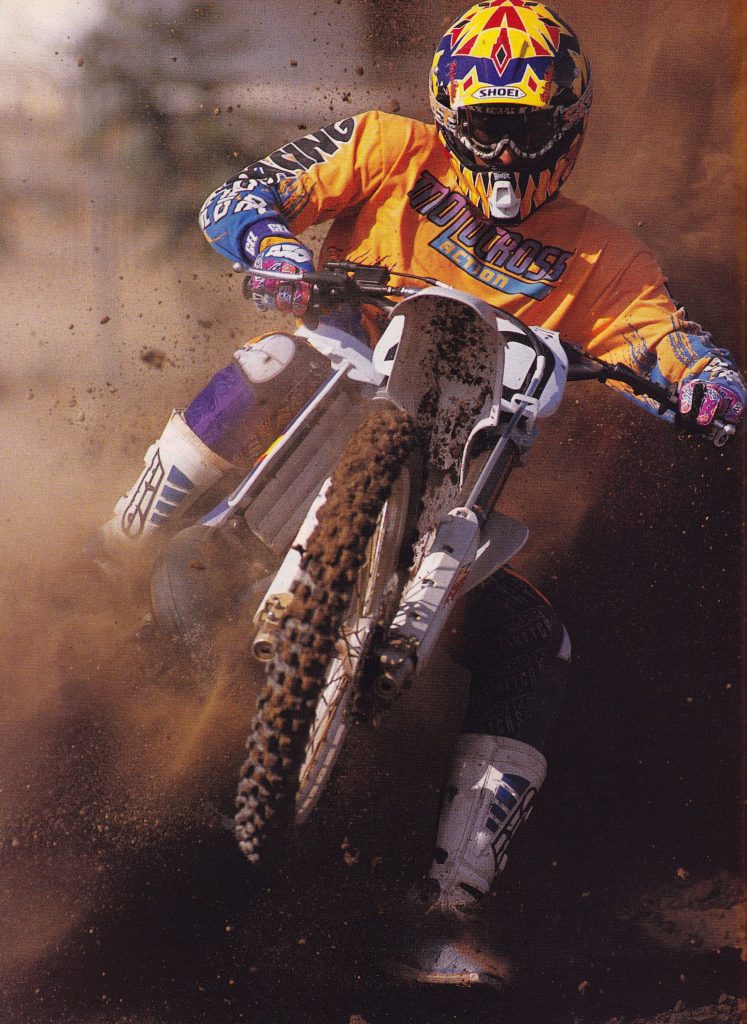 Smooth Operator: On the dyno, the 1994 YZ250 pumped out major ponies, but on the track, its electric delivery made it feel somewhat slow. By adding a RAD Valve and YZR exhaust, the Yamaha’s personality perked up significantly. Photo Credit: Motocross Action
Smooth Operator: On the dyno, the 1994 YZ250 pumped out major ponies, but on the track, its electric delivery made it feel somewhat slow. By adding a RAD Valve and YZR exhaust, the Yamaha’s personality perked up significantly. Photo Credit: Motocross Action
The ultra-wide powerband worked perfectly with the new transmission ratios and the YZ rarely felt as if it was in the wrong gear. It was always on the pipe, hooked up, and ready to rail the next turn or clear the next double. The new transmission remained notchier than the competition, but it rarely missed shifts and worked decently enough to get the job done. The new clutch was also an improvement, but it remained a significant step behind the Honda’s in feel and durability. It held up to abuse much better than in 1993, but its action remained grabby and inconsistent once it got hot. Thankfully, however, the YZ’s ultra-wide powerband made hammering and abusing the clutch unnecessary in most situations.
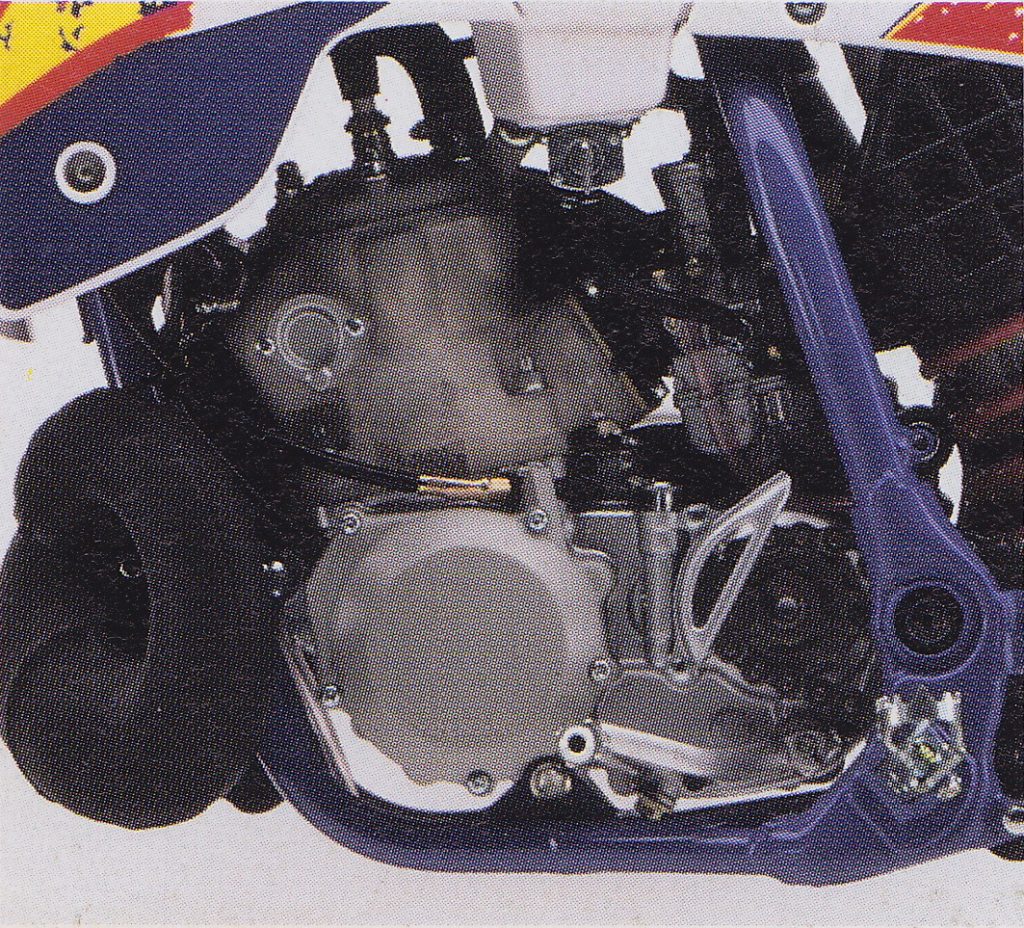 In stock condition, the 1994 YZ250 motor was the silent assassin of the ’94 250 class. Its smooth power delivery deceived many into thinking it was slow until they watched it hook up and pull away. It was sneaky fast and super easy to ride with a long pull and flexible powerband. Pros complained about the lack of hit, but for most riders, it was an excellent motocross motor. Photo Credit: Yamaha
In stock condition, the 1994 YZ250 motor was the silent assassin of the ’94 250 class. Its smooth power delivery deceived many into thinking it was slow until they watched it hook up and pull away. It was sneaky fast and super easy to ride with a long pull and flexible powerband. Pros complained about the lack of hit, but for most riders, it was an excellent motocross motor. Photo Credit: Yamaha
For riders looking for more power from their YZ, Yamaha’s in-house Wrench Reports had several fixes in 1994. By bolting on a YZR pipe and silencer (designed and built by Pro Circuit) and swapping out the stock reed cage for a Boyesen RAD valve the YZ’s personality changed quite dramatically. This combination dialed up a bunch more midrange hit and improved the YZ’s pull on top. It did make the Yamaha harder to ride but pros and throttle jockeys appreciated the livelier motor performance.
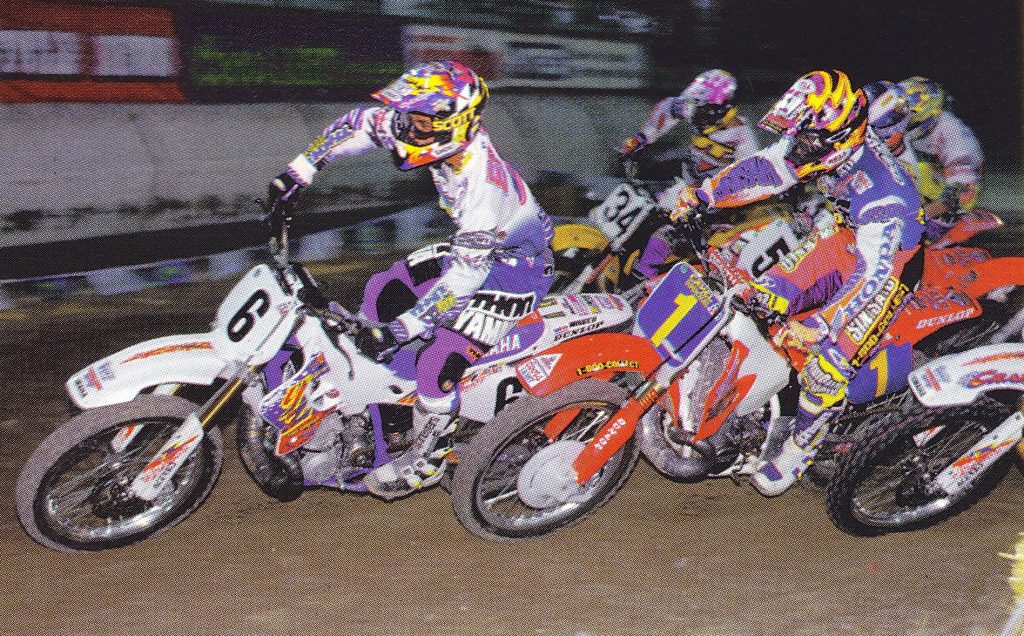 If you were looking for serious power out of your ’94 YZ250, then the true hot setup was a long rod kit. The Factory Yamaha team and several privateers ran these kits in 1994, and it turned the mild-mannered YZ into an absolute holeshot machine. The sight of YZs leading the pack into the first turn became a familiar refrain during the 1994 Supercross and 250 National Motocross season.
If you were looking for serious power out of your ’94 YZ250, then the true hot setup was a long rod kit. The Factory Yamaha team and several privateers ran these kits in 1994, and it turned the mild-mannered YZ into an absolute holeshot machine. The sight of YZs leading the pack into the first turn became a familiar refrain during the 1994 Supercross and 250 National Motocross season.
On the suspension front, the new shorter YZ was mostly a success. The KYB forks worked well in most situations and were admirably plush in the rough. The new stiffer fork springs delivered improved performance and reduced bottoming, but some heavier and faster riders still felt the YZ would have benefited from stiffer coils. Raising the oil level slightly and dialing in the available adjustments worked well enough for most riders not named Craig or Emig. They were far better sorted than the Showa forks found on the Honda and Suzuki and easily ranked as the second-best silverware available behind the ultra-plush Kawasaki in 1994.
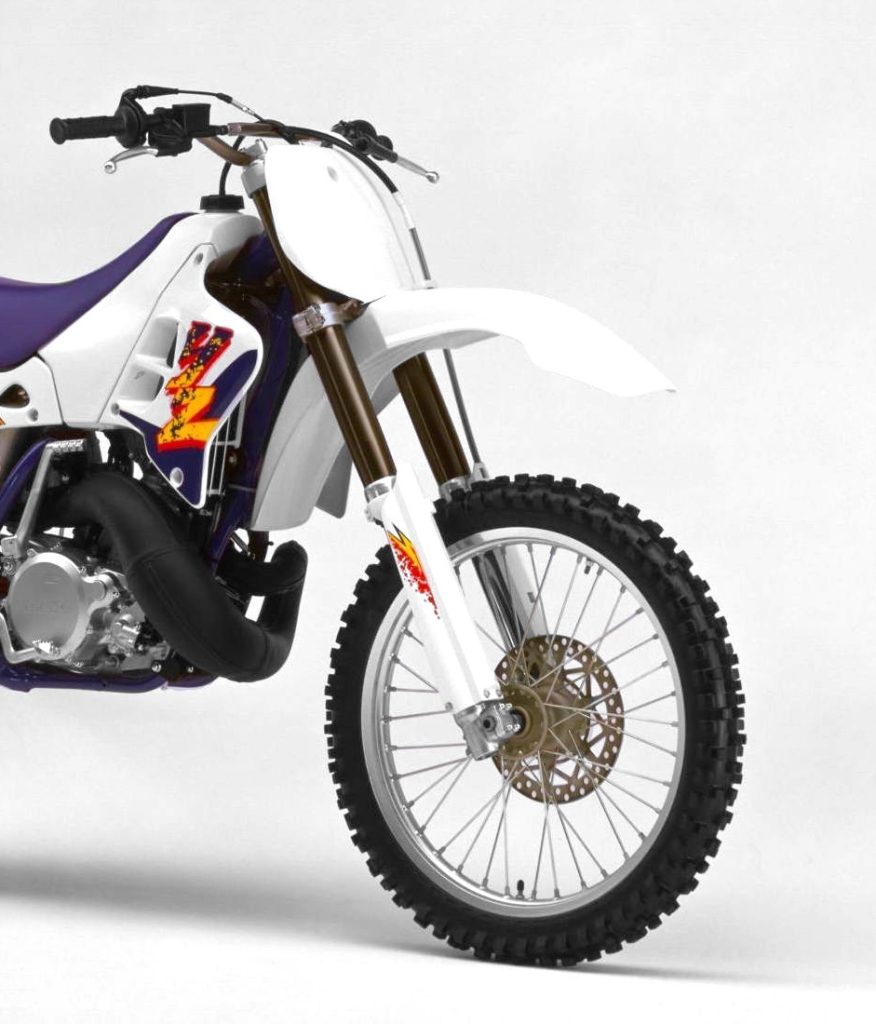
All-new forks for 1994 reduced travel and stiffened overall action. The revamped front end improved turning and delivered an excellent ride that handled small and large hits with aplomb. Photo Credit: Yamaha
In the rear, the revamped Kayaba damper was improved but it still suffered from a tendency to drop down aggressively under acceleration. This affected the YZ’s front-end traction and caused its shock to drop into the heavier part of its damping curve out of turns. If the track was rough and choppy, this wall of damping transmitted the bumps directly to the rider’s backside. In 1993, the YZ had suffered from this same malady and many expected Yamaha to revise the linkage rate to combat this in 1994. Yamaha claimed the new shorter shock and revised damping alleviated the need for a new linkage, but many riders did not share this opinion. The best solution for this quirk was to swap out the linkage for an aftermarket alternative from Devol or Pro Circuit, but if you did not want to spend the cash then dialing up some additional preload was the next best fix. Instead of the traditional 100mm of sag, the Yamaha’s rear suspension worked best with somewhere between 95mm and 93mm. This helped keep the YZ’s rear from dropping under acceleration and turning the machine into a chopper out of turns.
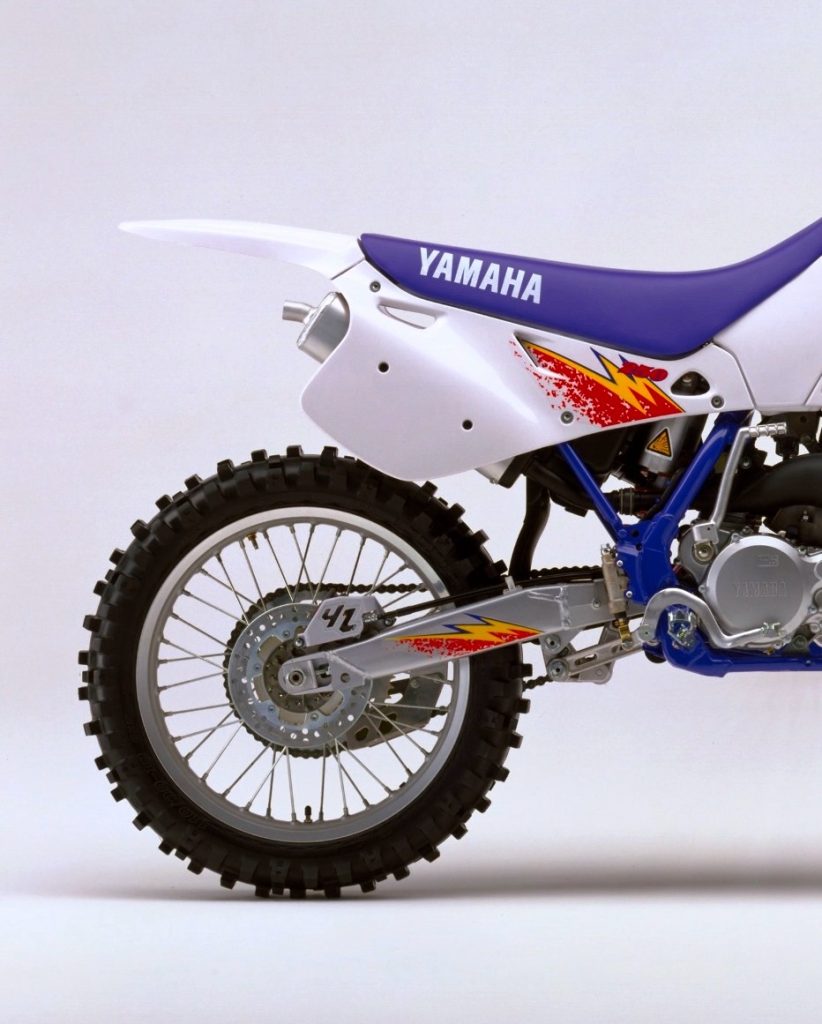 In the rear, the situation was a bit more complicated. Many riders felt the Yamaha’s stock shock was too soft initially and prone to dropping into the stiff part of its travel under acceleration. The quick fix for this was to crank up the preload, but the most effective way to address the droop was to replace the stock linkage with an aftermarket alternative. Once this was sorted the YZ’s rear end was the second best damper in the 1994 250 division. Photo Credit: Yamaha
In the rear, the situation was a bit more complicated. Many riders felt the Yamaha’s stock shock was too soft initially and prone to dropping into the stiff part of its travel under acceleration. The quick fix for this was to crank up the preload, but the most effective way to address the droop was to replace the stock linkage with an aftermarket alternative. Once this was sorted the YZ’s rear end was the second best damper in the 1994 250 division. Photo Credit: Yamaha
Once the preload was increased, the YZ’s rear shock worked much better overall. It no longer jackhammered the rider’s rear out of turns and tracked much better on small chop. It took big hits well and never did anything weird or scary. Its action was less plush than the excellent rear of the KX but was better liked than the shocks on the CR and RM. Fast riders felt the rebound was a bit quick and its spring was a bit too soft, but for most riders, it worked well with a bit of fine-tuning.
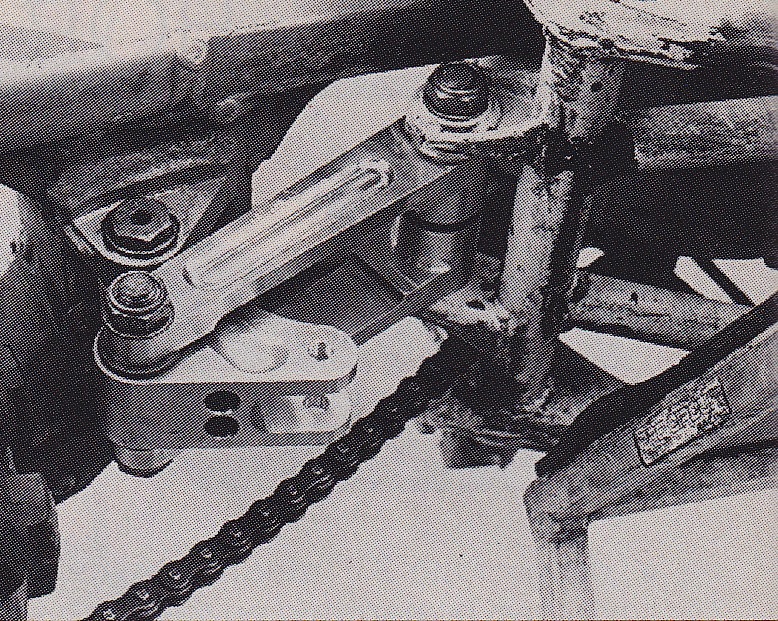 Devol Racing sold a lot of aftermarket links to riders looking to stop the Yamaha drop in 1994. Photo Credit: Motocross Action
Devol Racing sold a lot of aftermarket links to riders looking to stop the Yamaha drop in 1994. Photo Credit: Motocross Action
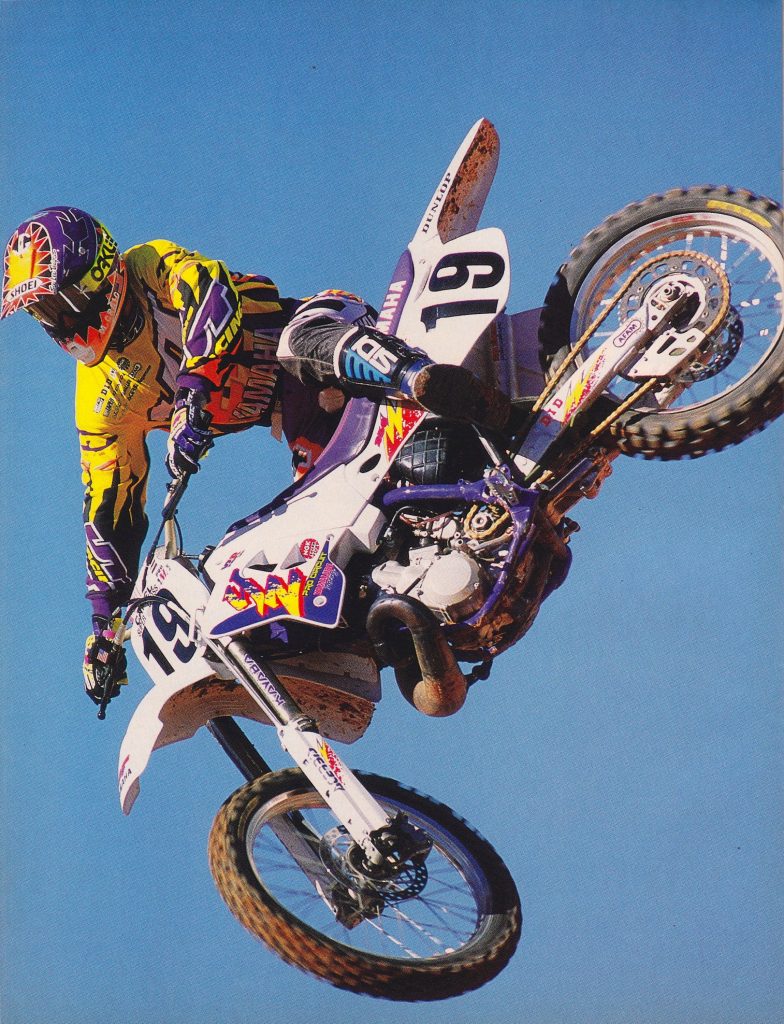 Getting the boot: The Mike Craig experiment turned out to be a real mixed bag for Yamaha in 1994. In Supercross, Stingray captured three podiums and a very popular win at Tampa, but by the time the outdoors started, the relationship was becoming strained. A non-appearance at a race after reportedly tripping on his boot at the hotel was the straw that finally broke the camel’s back for Yamaha’s patience with Craig. Despite his results on the track, Craig was let go by the Yamaha brass and left looking for a ride for the outdoors. Craig would make the switch to Phil Alderton’s Honda of Troy squad at the Hangtown round and become a mainstay of the HOT team for the next four seasons. Photo Credit: Kinney Jones
Getting the boot: The Mike Craig experiment turned out to be a real mixed bag for Yamaha in 1994. In Supercross, Stingray captured three podiums and a very popular win at Tampa, but by the time the outdoors started, the relationship was becoming strained. A non-appearance at a race after reportedly tripping on his boot at the hotel was the straw that finally broke the camel’s back for Yamaha’s patience with Craig. Despite his results on the track, Craig was let go by the Yamaha brass and left looking for a ride for the outdoors. Craig would make the switch to Phil Alderton’s Honda of Troy squad at the Hangtown round and become a mainstay of the HOT team for the next four seasons. Photo Credit: Kinney Jones
On the handling front, the YZ was excellent overall once the preload was dialed up in the rear. It offered the most well-rounded set of handling traits in the class. Some bikes turned, and some bikes went straight, but very few could pull off both with the composure of the versatile YZ. The new clamps, shorter travel suspension, and stouter frame provided the updated Yamaha with excellent steering response and improved front-end traction. It was not quite as eager to dive to the inside as the Honda and Suzuki, but most riders found little fault with the YZ’s moves once the track got twisty. High-speed handling remained excellent, and the Yamaha was rock solid down fifth gear straights. It was not as flickable in the air as the high-flying Honda and Suzuki, but it flew straight and went where it was pointed. Supercross specialists like Jeremy McGrath were probably happier on the more aggressive CR and RM, but for many riders, the Yamaha offered the best combination of turning and stability in the class.
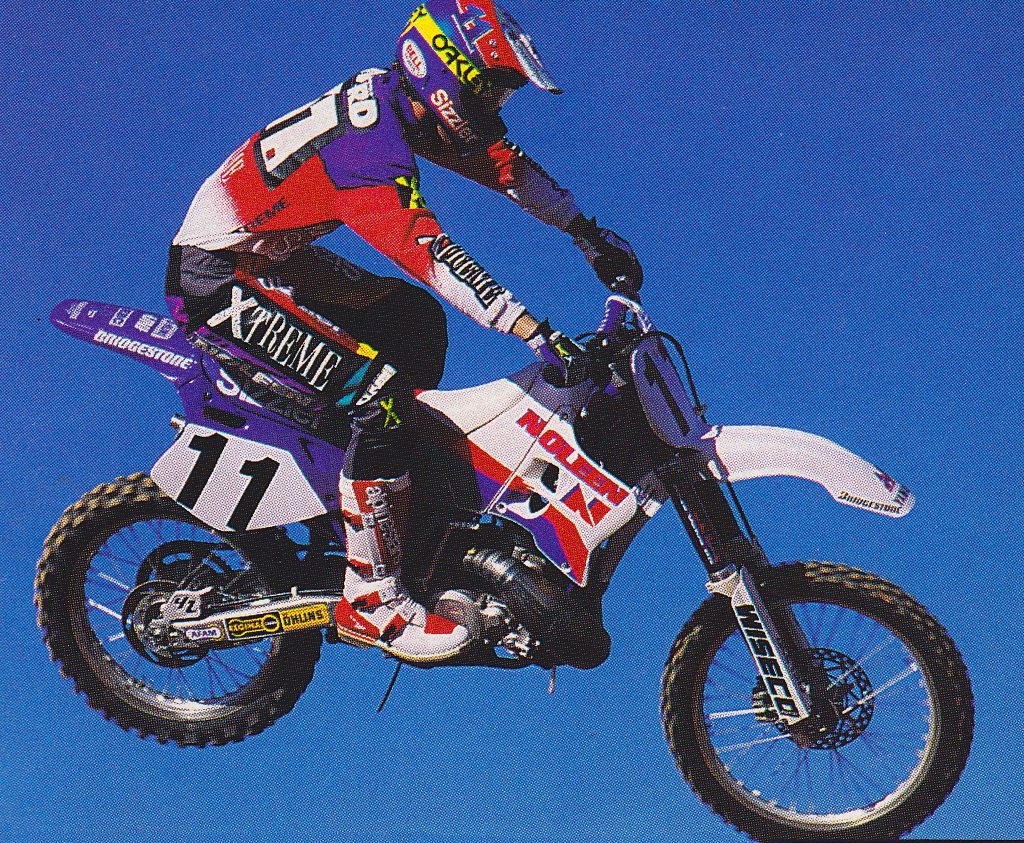 Despite the stock bike’s mild personality, The YZ250 proved a very popular privateer machine in 1994. Racers like Larry Ward were frequently seen at the front on their YZs giving the factory boys all they could handle. Photo Credit: Dirt Bike
Despite the stock bike’s mild personality, The YZ250 proved a very popular privateer machine in 1994. Racers like Larry Ward were frequently seen at the front on their YZs giving the factory boys all they could handle. Photo Credit: Dirt Bike
In terms of detailing, the YZ250 was a middle-of-the-pack performer in 1994. The smooth motor was a hit with many, but no one appreciated its appetite for race gas. The stock motor liked to ping on pump gas and no amount of jet fiddling would alleviate the knock completely. A 50/50 mix of the good stuff was the only surefire way to exorcise the rattle from the top end. The new transmission ratios were also a hit, but the shifter’s cranky engagement remained a disappointment. The old-school YPVS design was getting a bit long in the tooth by 1994, but its comparatively simple design made top-end services less complicated than on many of the YZ’s rivals. The YZ’s stock alloy silencer was light, and it looked trick, but many riders panned its tinny exhaust note. Aside from the annoying pinging and bit of vibration, the Yamaha motor held together well and was quite reliable overall.
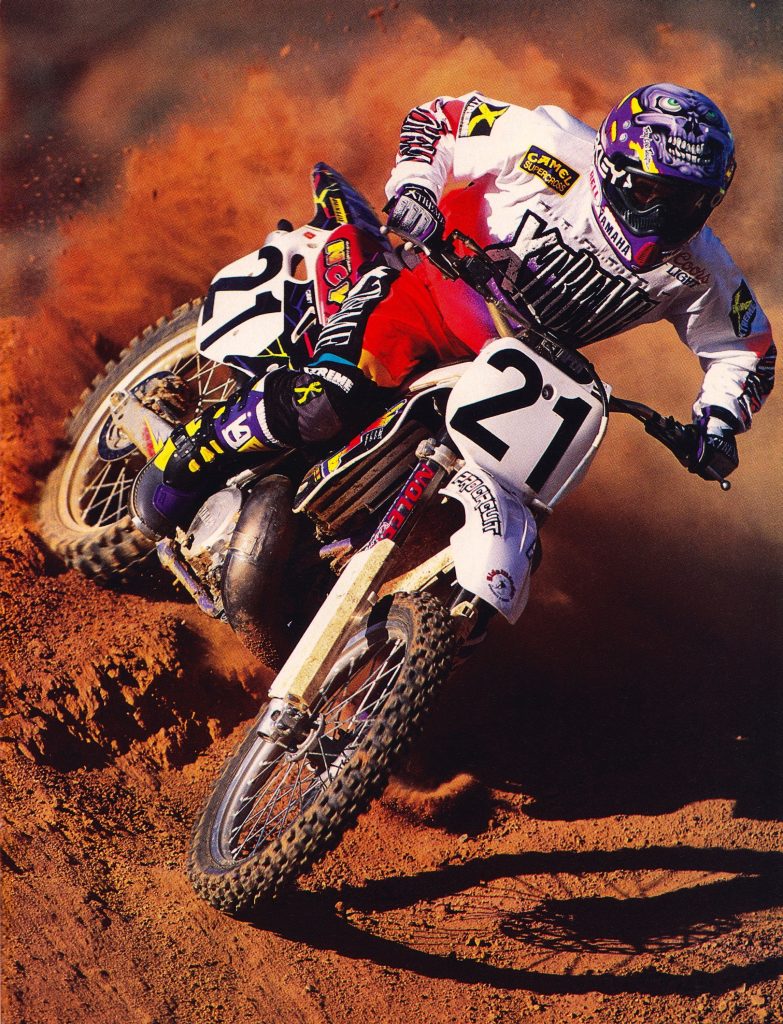 Jeff “Chicken” Matiasevich was another high-profile rider choosing to ride lavender in 1994. After losing his factory ride with Suzuki at the end of the 1993 season, Matiasevich chose North County Yamaha and the YZ250 to resurrect his career in 1994. Several top five rides would land Chicken a full factory ride in Japan for 1995 where he would go on to capture three consecutive All-Japan 250 Motocross titles for Kawasaki. Photo Credit: Kinney Jones
Jeff “Chicken” Matiasevich was another high-profile rider choosing to ride lavender in 1994. After losing his factory ride with Suzuki at the end of the 1993 season, Matiasevich chose North County Yamaha and the YZ250 to resurrect his career in 1994. Several top five rides would land Chicken a full factory ride in Japan for 1995 where he would go on to capture three consecutive All-Japan 250 Motocross titles for Kawasaki. Photo Credit: Kinney Jones
The new flatter seat made rider movement easier for 1994, but some riders felt the taller pegs made the rider compartment feel a bit cramped. The seat foam was also quite soft and tended to sack out rather quickly negating some of the benefits of the taller profile. Adding a taller CR bend handlebar and a firmer CEET Racing saddle helped alleviate this problem for those feeling a bit scrunched. The YZ’s bodywork was handsome overall with excellent hand holds molded into the side plates. Some riders did feel the tank was a bit wide when compared to the razor-thin Honda, but it was not an issue unless you did a lot of switching between the two. The reinforcements molded into the shrouds and side plates for 1994 were only partially effective as the holes tended to crack instead of just allowing the bolts to slip through. Adding rubber grommets to the tank and shroud bolts was a good idea to keep everything together.
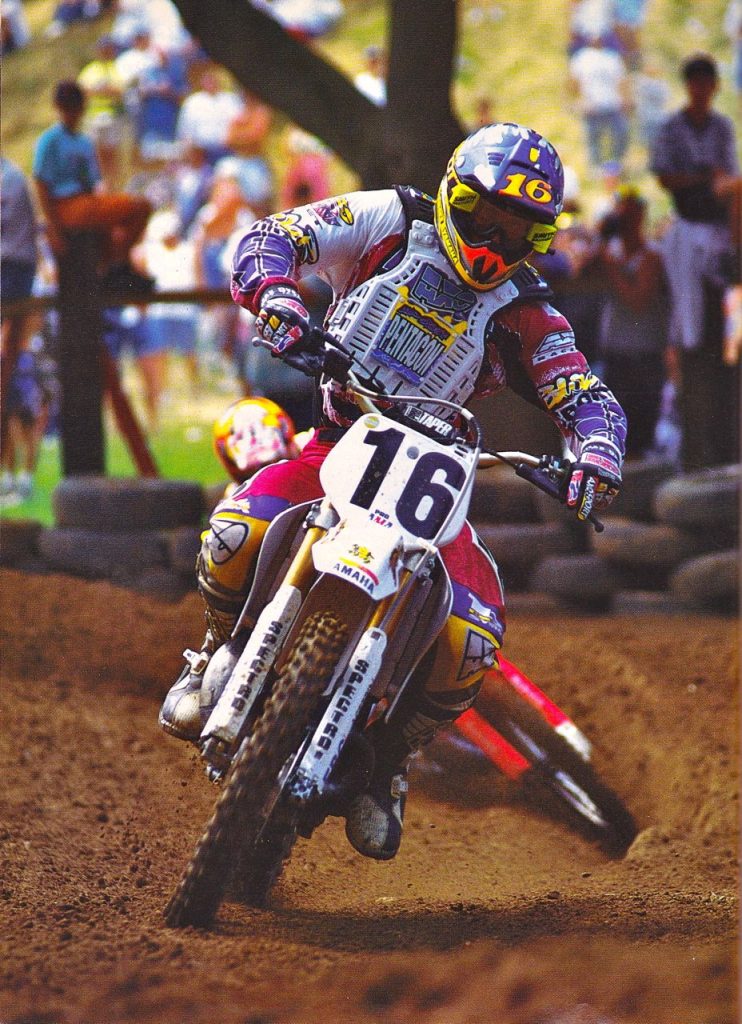 After the departure of Mike Craig, Yamaha had an extra works bike under the tent, so they offered it to Boyesen Yamaha’s John Dowd for the final rounds of the 1994 Motocross season. Dowd would repay the loan by piloting Craig’s old machine to a very popular victory at Millville. Photo Credit: Motocross Action
After the departure of Mike Craig, Yamaha had an extra works bike under the tent, so they offered it to Boyesen Yamaha’s John Dowd for the final rounds of the 1994 Motocross season. Dowd would repay the loan by piloting Craig’s old machine to a very popular victory at Millville. Photo Credit: Motocross Action
The bolts and fasteners found on the Yamaha were better than the pot metal found on the Kawasaki and Suzuki but a far cry from the industrial-grade materials holding together the Honda. The steel bars, sprockets, chain, levers, and grips were of unimpressive quality and best replaced by aftermarket alternatives. Braking performance on the YZ was middle of the pack in 1994. It offered good performance up front but lackluster bite in the rear. The brakes were reliable and rarely needed servicing, but their performance was just not as strong as the binders found on the Honda and Suzuki.
 Once the rear sag was sorted the 1994 YZ250 was an excellent handler. It was reasonably sharp in the turns and rock solid at speed. No other 250 was as versatile a do-it-all handler in 1994. Photo Credit: Yamaha
Once the rear sag was sorted the 1994 YZ250 was an excellent handler. It was reasonably sharp in the turns and rock solid at speed. No other 250 was as versatile a do-it-all handler in 1994. Photo Credit: Yamaha
In the end, the 1994 Yamaha YZ250 proved to be a very competitive, but slightly polarizing machine. Its deceptively fast motor had what it took to run at the front, but its ultra-smooth delivery was anything but exciting. Its electric powerband got the job done, but many riders preferred the snap and punch offered by the green, yellow, and red competition. Its suspension worked well, and its chassis could do it all, but the Yamaha lacked some of the verve that drew riders to its rivals. It was a machine that covered all the bases but did it in a way that failed to elicit much excitement. If winning races was your top priority, then the YZ was an excellent choice, but if you wanted a bit of spice from your deuce-and-a-half, then Yamaha’s entry might leave you feeling cold.
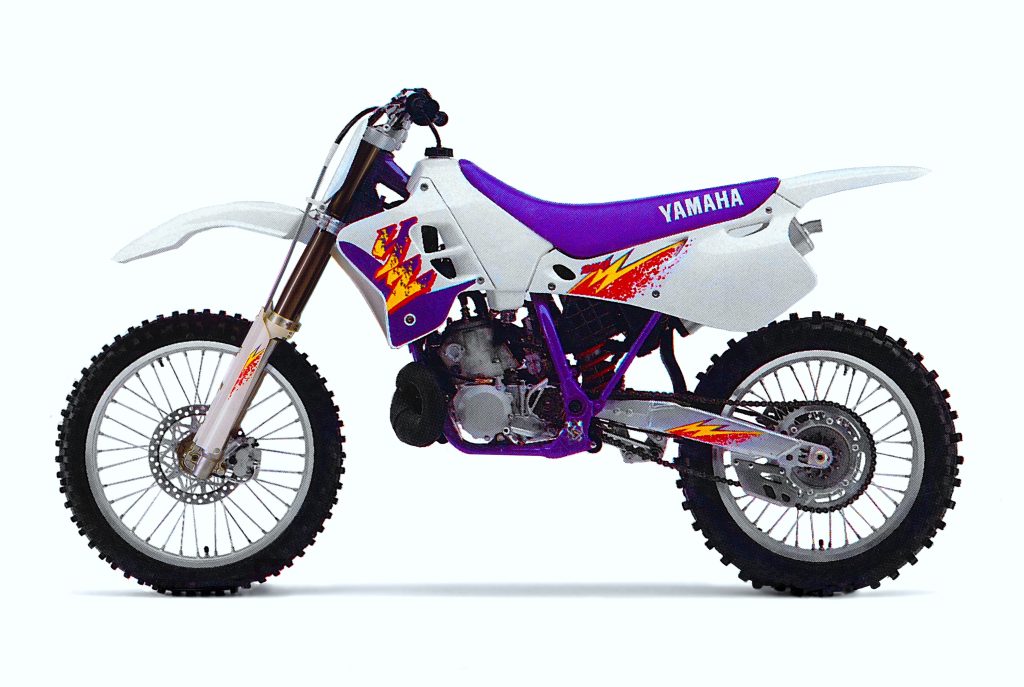 Lavender and lighting bolts aside, the 1994 Yamaha YZ250 was a fairly conservative machine. Its electric powerband and down-the-middle handling package failed to elicit much excitement, but if winning races was your goal, then the Why Zed had the right stuff in 1994. Photo Credit: Yamaha
Lavender and lighting bolts aside, the 1994 Yamaha YZ250 was a fairly conservative machine. Its electric powerband and down-the-middle handling package failed to elicit much excitement, but if winning races was your goal, then the Why Zed had the right stuff in 1994. Photo Credit: Yamaha

